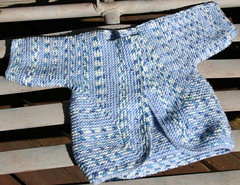I finally finished it last night. Well, finished except for washing, blocking, and sewing on buttons. I took a picture of it this morning and without further ado, I give you :
Amy's Baby Surprise Jacket

I have to say, it turned out so much better than I expected (Ravelry link to project). From previous posts, you know that I was having fits about pattern and yarn combinations. I couldn't settle on yarn or an acceptable pattern. After doing some research on the subject, I discovered Elizabeth Zimmerman's Baby Surprise Jacket (BSJ) (Ravelry link) and ordered the expanded pattern from Schoolhouse Press. This turned out to be an excellent decision because I'm not sure I would've managed it without the line by line instructions.
After deciding on the pattern, I had to find the right yarn since the stuff I purchased originally wasn't nice enough for the BSJ. On a whim, I went to the Yarn Garage in Rosemount (my LYS) and found this lovely blue and white variegated baby yarn by Feza. It seemed perfect for the BSJ, so a purchased one skein and took it home to swatch. The swatch yielded cute little stripes and I began to worry that it would pool in the BSJ. After so much work though, I decided to just go with it and if it knitted up horrifically, I would find something else. Obviously, it worked out very nicely!
The pattern itself tripped me up a handful of times, but I was able to figure it out largely on my own. Here are some notes from my project journal:
June 3rd, 2009 -
Ravelry Link (pattern): http://www.ravelry.com/patterns/library/baby-surprise-jacket
Started: June 1st, 2008
Made For: Amy and her baby, due at the end of July
Yarn: Feza Super Soft Baby, 100grams, 100% acryllic, sport weight, K1746 dye lot, 803 color
Care Instructions: No iron, wash 30 degrees, dry clean, no bleach
Needles: Addi Click, 24", US 7
12 rows complete after a few mis-starts. Took me a few tries to get the counting correct at the beginning. Solved the issue by putting stitch markers in every 20 stitches, plus markers at the double decrease (slip knitwise, k2tog, psso).
Row 11 with the increases took some time to figure out as well. Instructions say "[k3, m1]," which I took to mean k3, kfb. It actually means k2, kfb.
Not convinced this yarn will work for the pattern. It's multi-colored and striped nicely in my little gauge swatch, so I'm afraid of significant pooling as I continue. So far, so good. I suspect pooling issues may be obvious about halfway through the sweater.
I adore the pattern. It's complicated and requires quite a bit of faith that it will all turn out correctly at the end. So far, I'm really enjoying both aspects of the project. Depending upon the finished project, I may make more of these (whether I have friends expecting or not!).
June 10th, 2009 -
Up to row 64! The increases are a little tricky. It says (m1, k1 m1), but I've interpreted it as (kfb, kfb). If the pattern says k27, inc, k54, inc, k27, here's what I actually do: k26, kfb, kfb, k53, kfb, kfb, k27. I'm not sure if that's right, but it gives me the right count and it seems to be working out. Heh, we'll see when it's done!
I am still enjoying this pattern. Even though it's just garter stitch, the increases and decreases make it just challenging enough to hold my attention. I'd totally knit this again.
June 22nd, 2009 -
Finished! Such a great looking little jacket now that it's done. Well, I have to buy buttons and sew them on, but otherwise it's finished. ;)
I ran out of yarn with two rows to go. Luckily the Yarn Garage had one skein left of the yarn I used, so I was able to finish it without any difficulty. And now I have nearly a whole skein of yarn left, so I'm knitting a matching hat (Ravelry link)! I will give Amy whatever yarn I have left in case she wants to modify the jacket at all. That's the nice thing about giving a hand-knit sweater to another knitter.
Let's see, comments on the pattern. Rows 73-75 gave me a lot of trouble. It says to cast off 5 sts, then knit the remainder, but to get the count correct, you have to cast off 6 sts, which is what I did. In reality though, you cast off 5 sts and knit the extra stitch. When I got to row 75, I was a stitch short at the end of the row, so I had to make a stitch. You can't even tell that I made one, but that is definitely something to keep in mind for future BSJs. Other than that, I had very few difficulties with the pattern and would absolutely knit one of these again.

I have to say, it turned out so much better than I expected (Ravelry link to project). From previous posts, you know that I was having fits about pattern and yarn combinations. I couldn't settle on yarn or an acceptable pattern. After doing some research on the subject, I discovered Elizabeth Zimmerman's Baby Surprise Jacket (BSJ) (Ravelry link) and ordered the expanded pattern from Schoolhouse Press. This turned out to be an excellent decision because I'm not sure I would've managed it without the line by line instructions.
After deciding on the pattern, I had to find the right yarn since the stuff I purchased originally wasn't nice enough for the BSJ. On a whim, I went to the Yarn Garage in Rosemount (my LYS) and found this lovely blue and white variegated baby yarn by Feza. It seemed perfect for the BSJ, so a purchased one skein and took it home to swatch. The swatch yielded cute little stripes and I began to worry that it would pool in the BSJ. After so much work though, I decided to just go with it and if it knitted up horrifically, I would find something else. Obviously, it worked out very nicely!
The pattern itself tripped me up a handful of times, but I was able to figure it out largely on my own. Here are some notes from my project journal:
June 3rd, 2009 -
Ravelry Link (pattern): http://www.ravelry.com/patterns/library/b
Started: June 1st, 2008
Made For: Amy and her baby, due at the end of July
Yarn: Feza Super Soft Baby, 100grams, 100% acryllic, sport weight, K1746 dye lot, 803 color
Care Instructions: No iron, wash 30 degrees, dry clean, no bleach
Needles: Addi Click, 24", US 7
12 rows complete after a few mis-starts. Took me a few tries to get the counting correct at the beginning. Solved the issue by putting stitch markers in every 20 stitches, plus markers at the double decrease (slip knitwise, k2tog, psso).
Row 11 with the increases took some time to figure out as well. Instructions say "[k3, m1]," which I took to mean k3, kfb. It actually means k2, kfb.
Not convinced this yarn will work for the pattern. It's multi-colored and striped nicely in my little gauge swatch, so I'm afraid of significant pooling as I continue. So far, so good. I suspect pooling issues may be obvious about halfway through the sweater.
I adore the pattern. It's complicated and requires quite a bit of faith that it will all turn out correctly at the end. So far, I'm really enjoying both aspects of the project. Depending upon the finished project, I may make more of these (whether I have friends expecting or not!).
June 10th, 2009 -
Up to row 64! The increases are a little tricky. It says (m1, k1 m1), but I've interpreted it as (kfb, kfb). If the pattern says k27, inc, k54, inc, k27, here's what I actually do: k26, kfb, kfb, k53, kfb, kfb, k27. I'm not sure if that's right, but it gives me the right count and it seems to be working out. Heh, we'll see when it's done!
I am still enjoying this pattern. Even though it's just garter stitch, the increases and decreases make it just challenging enough to hold my attention. I'd totally knit this again.
June 22nd, 2009 -
Finished! Such a great looking little jacket now that it's done. Well, I have to buy buttons and sew them on, but otherwise it's finished. ;)
I ran out of yarn with two rows to go. Luckily the Yarn Garage had one skein left of the yarn I used, so I was able to finish it without any difficulty. And now I have nearly a whole skein of yarn left, so I'm knitting a matching hat (Ravelry link)! I will give Amy whatever yarn I have left in case she wants to modify the jacket at all. That's the nice thing about giving a hand-knit sweater to another knitter.
Let's see, comments on the pattern. Rows 73-75 gave me a lot of trouble. It says to cast off 5 sts, then knit the remainder, but to get the count correct, you have to cast off 6 sts, which is what I did. In reality though, you cast off 5 sts and knit the extra stitch. When I got to row 75, I was a stitch short at the end of the row, so I had to make a stitch. You can't even tell that I made one, but that is definitely something to keep in mind for future BSJs. Other than that, I had very few difficulties with the pattern and would absolutely knit one of these again.
 subscribe
subscribe

2 comments:
That's awesome! I am so very envious! Now I want to make one. Right now.
the effect of making tea.Purple sand pot does not apply glaze inside and outside, maintains small pores, has good permeability, but impervious to water, and has strong adsorption, which is not comparable to the general teapot, it can keep the aromatic oil in the tea from heat volatilization and form fragrance, improve the late acidity of tea soup, play a role of convergence and sterilization
History
Purple sand pottery is a unique pottery handicraft in China. It is famous forChina Purple Clay Teapot its diverse shapes, quaint color, durable quality and exquisite technology. Since the song dynasty, the production of purple sand Yixing Purple Clay Teapot Setpottery in Ming dynastPurple Clay Teapot With Infusery has formed a relatively complete technological system.In the early qing dynHandmade Ceramic Teapotasty, the making of zisha pot came into its heyday. In the early qing dynasty, geometric ware was very popular
Play collection
If limited by economic income, the award-winning works or representative works created by art artists or assistants can also be selected for collection.TheCheap Ceramic Teapots charactAuthentic Purple Clay Teapoteristic of the work
Post a Comment